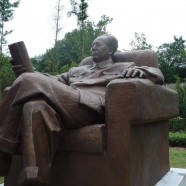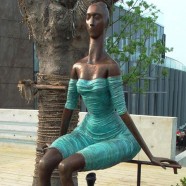Gold Gilt Bronze Sculpture
Gold gilding is a traditional decorative technique for applying gold leaf to solid surface such as metal, wood, stone. Gold leaf is extremely thin. The average thickness is around 2.4 μ ,whose thickness is only one tens of diameter of a hair. Sculptors worldwide have been long applying gold gilding onto their sculptures. Egypt is one of the earliest to use this technique. In ancient China, sculptors gold gild on bronze sculpture such as Buddha. This made craftsman master the technique quite well because gold gilding is a way to expressing their respect toward Buddha. Japan is another country which master this technique fluently. Tany Foundry, as a leading sculpture foundry in China, has been casting bronze and gold gilding for 30 years. Here are some of benefits of applying gold gilding onto sculptures. Gold, with its luster, makes the sculpture looks really beautiful. Below is the gold gilt sunflowers and lotus Tany Foundrymade for one of the top Chinese artist Xu Jiang.The sculptures are bronze casting and we apply gold leaves onto every single sunflowers, lotus and stone. With proper finish treatment, gold gilding is highly anti-oxidation, which means the sculpture can keep its luster over years.Here are some of gold gilt bronze athlete sculptures Tany Foundry made over 10 years ago. They look just like brand new now even though they are not maintenance regularly. To make the most from gold gilding, we have some tips for sculptors planning to use this technique. If funding allows, use 22K or 24K gold leaf instead of those with lower gold percentage. This could make the gilt sculpture last its luster much longer. Hire skillful gilding craftsman. They can save you a lot of budget. Experienced craftsman is able to make best use of each gold leaf without wasting. Also, they can make a big difference on the final finishing effect. Apply a clear coating after the gilding is finished. The coating works as a protective layer on the gold finish. Feel free to let us know if you have any technical question about gild gilding. Please click...
Read MoreDream Boat: Copper Sculpture Fabrication
Bronze and copper is often used for sculpture fabrication. Tany Foundry has a team of professional and very experienced artisan. Copper, which is of great extension ability under high temperature, is an excellent material for art fabrication. Before the plastic is invented, copper is one of the most used materials for making everyday utensil: bowl, table, etc. Now plastic and other new material take place of copper but copper successfully find its way into modern art and ornament purpose. Compared with bronze casting, it’s relatively easier to explain how copper fabrication works. To put it simple, fabrication is forming the metal into the desired shape with multiple steps: cutting, welding, bending, finishing, polishing, assembling and other methods. Here is a case of Tany Foundry copper fabrication sculpture. This sculpture is called dream boat which is fabricated with copper, 45 feet long. Overall, the sculpture is made up of two parts, the wave like copper tubes and the curved deck. Here are basic steps how we fabricate it. Fabricate an armature with galvanized steel, which works as a skeleton and support of the whole sculpture. We have to make sure the armature is very strong because whole sculpture weights on it. Prepare copper sheets of 2MM thick and weld them together to the curve required in the drawing and weld them with the armature. Bending copper tubes an welding tubes together to the desired length. This is a very important step in the whole process because the tube shape wave is the major visual feature of this work. The patterns of the wave are carefully designed. We lay the drawing on grounds and shape bronze tubes rigidly following the pattern. Mount the bent copper tubes onto the finished frame. Fix individual bronze tubes together welding and bolts. Finishing and Patina. Here are some pictures of this project. Please let me know if you have any question about the fabrication process. Please click...
Read MoreBronze Cast Sculpture in Varied Patinas
Bronze has been the most often used material for casting sculpture. This is because of the bronze property which could flow and fill all cavity of the mold and therefore reproduce artist’s original work. The so called bronze is actually not pure copper, instead it’s a alloy with a combination of copper and other elements. Silicone, tin and zinc are common element used for forming alloy. Another benefit of using bronze for casting sculpture is its ability to make varied patina. Bronze can react with other chemical easily to represent varies color. The commonly used technique for patina is torching approach and immersion approach, depending on the size of the sculpture. The Torching approach is suitable for middle or large scale sculpture. The first step is to clean the bronze body completely, remove any grease. This is the key step which would make a difference on the final effect. The grease remains would prevent the bronze reacting with the chemicals and leave inconsistent color on sculpture. Then brush and polish the bronze surface. This purpose of this step is not only clean those tiny in and out of the sculpture but also make chemical work with bronze more easily. After that, heat the bronze with torch up, spraying chemical solution onto the bronze. The most used chemical are cupric sulphate, ammonia compounds, etc. The craftsman torch the bronze surface sprayed with chemical solution and make sure the chemical reaction happens. Usually the process would be done a couple of times. There are multiple options for patina. Basically, there are four major color group:Brown; red, green, black. There are quite a few gradual alternatives and combinations of these colors. After reaching the desired patina, the craftsman would brush a thin lay of wax or apply coating onto the bronze sculpture. This could protect the bronze patina last longer. Below are a few of bronze sculptures we patina. If you have any technical question about patina, feel free to contact us....
Read MoreA Case Study of Stainless Steel Fabrication Public Art
In 2010, to celebrate Shanghai World Expo, we worked with artist Huaibing Guan to fabricate a stainless steel public artwork, called Travel in Time. This works measures 88 feet long and 13 feet wide. It’s fabricated with stainless steel by hand. This is a maze like structure with paths inside. People can go through the paths to experience of traveling in time. The whole maze are made up of around 30 separate pieces. The components of this works are square stainless tubes. We print out the drawing and bend, weld stainless tubes according to drawing. Stainless steel fabrication is a laborious works which requires the metal worker with rich experience and knowledge. One of the difficulty of this job is to make sure the separates pieces can fit with each other for installation. After the frame is complicated, we grind those welds to make sure it’s smooth. The final step is painting. According to the artist, we apply white painting onto stainless steel. After completion, we transport the works in Shanghai square and install it. If you have any question on this project or technical question about your own project, please email us....
Read MoreTips to Choose a Fine Art Foundry to Work With
After you spend tons of hours creating a sculpture, the next biggest consideration is to choose an reliable art foundry to cast your works. There are quite a few foundries in Europe, North America. So, how to target an ideal one? One of the best practices is hearing that your friends say. The foundry your friend recommend must get proven his own experience and therefore trustworthy. Another good way is via internet. There are tons of information these days on net: traditional website, social network service such as Facebook, Twitter, etc. One of the biggest advantages of social network is that you can communicate with the people from that foundry before you place an order. Usually, there are rich information you can learn from that foundry’s profile page: you can talk with the foundry about their past work, their casting methods, equipment, price, etc. The more you talk with him, the deeper you know about him. There are several factors you’d better take into consideration: 1. Quality. This is one of the most important factors. It’s easy to test a foundry’s quality by letting them do a small scale sculpture such as a life size bust. Then you can watch closely the casting’s finish, patination and other factors. The test casting is a good method to provide you with information for your further selection. 2. Cost. There are many foundries to choose from and you can compare their offers based their work quality into consideration. Nobody wants their carefully sculpted work riddled with imperfection or other poor finish and patination. You can make a list with potential foundries on it. Those foundries should be able to offer you quality work at a reasonable price. 3. Equipment and Technical process. It’s important to understand that small scale and large scale sculptures required different equipments and process. For small sculpture, foundry often use lost wax technique to cast and for large scale sculpture, they use sand casting. Most of small foundries only have lost wax casting equipment while those medium and large foundries have sand casting equipments. 4. Distance. People tend to work with short distance art foundry because that way they can communicate with the foundry easily and it’s easier for them to keep track of the process. The con of choosing based on distance is that the nearest foundry doesn’t always offer best quality at best price. With the developing logistics and long distance videoing technique ( transfer the picture or video of the process to sculptors lively), lots of sculptors can now work with a distant foundry closely with everything under control. The above are some tips for selecting an ideal art foundry for you. Your ideas or comments are appreciated. If you have any question or comment on how to select an art foundry, please click here....
Read More


